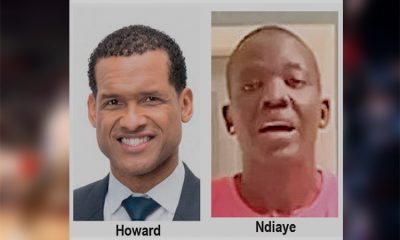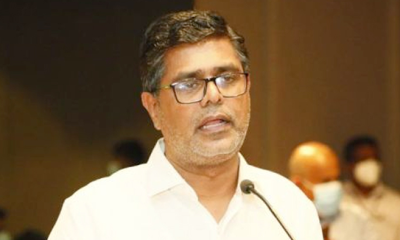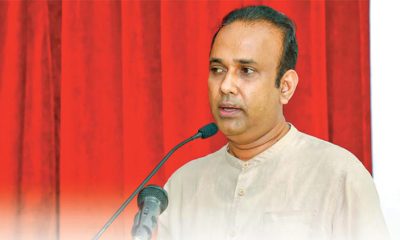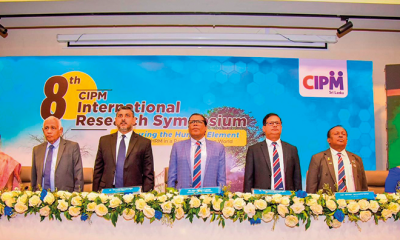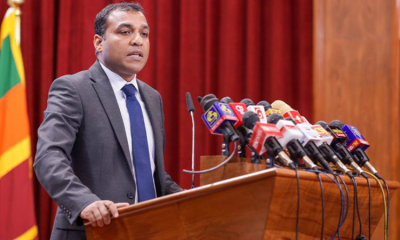Features
Sons and daughters of Edward Said and Hanan Ashrawi
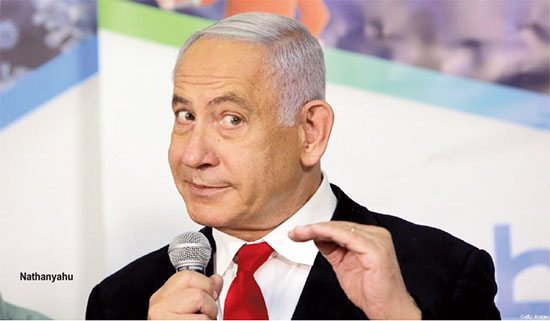
BY Kusum Wijetillake
Benjamin Netanyahu is on the brink; a centrist party and Yamina (right-wing coalition) are reported to have agreed to a strange alliance. A former journalist, Yair Lapid and Netanyahu’s (former) protégé, ex-Defence Minister Naftali Bennet lead the coalition partners; the latter is likely to be PM. Of course, never count ‘Bibi’ out.
Dr. Dayan Jayatilleka, a public intellectual, political scientist and former Sri Lankan Ambassador has observed the conflict closely for decades and played a key role in the successful battle for the admission of Palestine to UNESCO. He shares some thoughts on where the impasse might be heading.
KW – Israeli politics is in flux. Netanyahu is unable to form a coalition. Naftali Bennet is to the right of ‘BiBi’.
DJ
– “It is my hope and indeed my bet that Israeli society will not wish to be out of sync with mounting Western opinion. Netanyahu may hope that his friend Trump or someone with his views may make a comeback, but there’s been a seismic shift in consciousness which will never snap back. Jewish values are no longer preponderantly represented by Bibi Netanyahu and Benny Naftali. Three American figures of Jewish origin have contributed to this new, justice-centered consciousness: Noam Chomsky, Bernie Sanders and Richard Falk”.
KW – A number of resolutions and agreements on the two state solution do exist. How do the various resolutions, Oslo for example, affect the current status of the peace process?
DJ –
“On the face of it, the Israeli-Palestinian question is structurally intractable and irretrievably deadlocked. Note that I say ‘on the face of it’. As a formula the two-state solution is the best there is… builds on the logic of the original UN resolution of 1948, of two states, Israel and Palestine. It is the most reasonable solution. However, it was called into question from the beginning.”
“The Arab armies opened hostilities and the Israelis having beaten them soundly, did not stop at the borders traced by the UN resolution, which, with certain modifications due to strategic imperatives, would have been the most just and rational action. Instead, there was not only annexation but also eviction of Palestinian Arabs after the war had been won”.
“The Arabs erred by refusing to accept the UN resolution (which even Stalin’s Russia was an enthusiastic proponent of) and the legitimacy of the creation of the state of Israel – which was morally and historically irresistible after the Holocaust”.
KW – The two-state solution is under attack. Even during the Oslo Accords there was skepticism towards an acceptable two state solution.
DJ –
“The two-state solution has been rolled-back by cynical, systematic building of illegal Israeli settlements in the land that should belong to a future Palestinian state. In order to make the two-state solution viable again, those settlements would have to go, or there should be compensatory land-swaps. However, with each passing day, the Israelis leave less land to swap. It is difficult to envisage that the US will be able to mount enough pressure on Israel to roll-back the settlements”.
This leaves the one state solution. That has an interesting history. In recent years, the whistle was blown on the unviability of the two-state solution and a clarion call was sounded for a one state solution, firstly by Prof Richard Falk (Princeton University) the former UN Special Rapporteur on Occupied Palestine. He is Jewish. I am proud to have him as a friend”.
KW – Writing as recently as 2019, Prof. Falk stated: “the zombie maneuvers of the past 20 or more years with continued advocacy of long-moribund two statenegotiations must end: the only question is what kind of state will emerge – secular or apartheid”.
DJ –
“The one-state solution was initially the slogan of the Palestinian Marxist Left, notably Democratic Front for the Liberation of Palestine, though it was termed a ‘bi-national” state of Israelis and Palestinians possessing/exercising equal rights”.
“Given the apparent unviability of a two-state solution, the one-state solution is the only available default option. But that too is problematic. As President Barack Obama pointed out to the Israelis, who weren’t really listening, time is not on their side, because of demographics. Unless a surgical separation is effected by means of a two-state solution, Israel will be unable to exist as a democratic Jewish state. If it is to continue to claim to be the sole democratic state in the region and therefore the natural ally of the USA, it has to give citizenship, voting rights and equal rights in general, to all those who live within its borders. This would mean enfranchising all the Palestinians in the annexed territories. This in turn would change the demographic ratio, bringing into view the possibility that Israel would be democratic but no longer Jewish. Conversely Israel would remain Jewish by maintaining the status-quo but would be increasingly disqualified as democratic”.
KW – Oslo 1 was criticized for making unnecessary concessions without concrete proposals for a structure of a Palestinian State. The Status of Jerusalem, control of land and population registries, all postponed for later. The PLO legitimized itself as the representative of the Palestinians.
DJ –
“Edward Said, who had campaigned for and supported the recognition in the PLO Charter of the right of the state of Israel to exist also opposed the Oslo Accords but for a reason different from most critics on both sides. He opposed the calling off of the First Intifada (which unlike the second, was not an armed Intifada) by the PLO so as to arrive at the Accords. History has proved him right and today the Palestinians are back on the agenda precisely because of the recent uprising… Hanan Ashrawi was also a critic of the Oslo track as distinct from the Washington track in which she was the key PLO spokesperson. The Said-influenced discourse of Ashrawi, helped the PLO make headway in Washington, but the PLO hierarchy preferred the Oslo track and pretty much abandoned the Washington track”.
KW – There are some 500,000 settlers in the Palestinian Territories; illegal settlements per international law. Much of the Israeli political right supports expansion of these settlements.
DJ –
The Israelis sought to square the circle by accelerating settler-colonization and evictions, while remaining a western-style democracy within its core. That model was called out firstly and most audibly by former president Jimmy Carter, who defined Israel as increasingly an apartheid state—symbolized by its infamous walls and tight controls of every aspect of Palestinian life.
With Israel in no mood to dismantle its settlements or agree to land swaps (if those were possible anymore) so as to make for a two-state solution, or to extend democracy and equal rights to all the Palestinians within its self-proclaimed borders, the deadlock appears absolute.
KW – Could you comment on the ultra-religious, reactionary elements? Likud, while overtly secular, is linked to Herut who propose a ‘Land of Israel’, including present-day Jordan. The Shas Party, third largest in Israel, is ultra-religious and opposes a settlement freeze.
Hamas grew out of the Cairo based Muslim Brotherhood, is cloaked in Islamist ideology and explicitly calls for Israel’s destruction and the replacing of Palestine with an Islamic state.
DJ – “The Israelis erred by never accepting in their actions, the UN resolution and by succumbing at first covertly (under Labor Governments) and later overtly (under Likud) to an Old Testament notion of its borders”.
“Thus, secular, strategic and security imperatives, which were justifiable given the traumas of the holocaust, were overlaid by a Biblical mandate as it were, which made for expansionism and annexation. This zero-sum thinking on the part of both sides in 1948 was the Original Sin. It continues today, with the non-zero-sum political leaderships being marginalized on both sides. As for the Palestinians and the danger of a theocracy, Hamas will also have to evolve to retain the support of the new generation (which includes kids rapping in the rubble, in English!) and to win elections in the more sophisticated West Bank”.
KW – The mainstream media (MSM) is criticized for alleged one-sided cover age of the conflict. Palestinian activists say Israeli acts of aggression; evictions, settlement expansions, go unreported or that the Palestinian struggle is conflated with Hamas rocket fire.
Prof. Chomsky in a 2001 essay: “As in the rule of properly sanitized history, Palestinians carry out terrorism, Israelis then retaliate, perhaps too harshly. In the real world, the truth is often rather different” pointing out that Israeli terrorism is barely criticized in US media.
DJ – “The last time Israel fought a war against Gaza it went on for over 50 days. This time it stopped in 1/5th the duration. It was the first time ever that the mood on the Arab street coincided with the moral outrage on the American streets and in the US Congress, putting pressure on the US Government. From Gaza to New York and Chicago, from Jerusalem to Sydney, Palestinian flags are ubiquitous. One could not distinguish the coverage on CNN and the BBC from Al Jazeera. Israel lost the war of public opinion in the West, most significantly in the USA, and still more significantly, among the young American Jews. Another factor at work is the easy identification of Trump and Netanyahu in the minds of young Americans and young people in general the world over. The discourse and behavior of the Israeli rightwing mobs and the US Far Right which stormed the capitol on January 6th, are on a continuum. The ideology of the US Confederacy, revived by the US Far Right, and that of the Israeli religious Right, is easily recognizable as belonging to the same family”.
KW –In 2018, journalist Marc Lamont Hill was removed as a political commentator on CNN for a speech that was deemed anti-Semitic. Journalist Abby Martin’s event at a US University was cancelled because she refused to sign an anti-BDS (Boycott, Divest and Sanction) pledge. She is currently suing the State of Georgia. Emily Wilder, a journalist at the Associated Press was terminated last month due to complaints from alumni at Stanford University regarding her ‘past activism on Palestine’.
DJ – “The international media is no longer ‘manufacturing consent’ for Israel. That is the biggest change that I have seen in the recent Gaza conflict. There has been a major shift in the consciousness of Western journalists and anchors, as a result of struggle against Trump and Trumpism, and the coverage of the George Floyd murder, Police shootings and the Black Lives Matter protests. While Western journalists have shifted, so also have the TV channels because their own audiences (apart from FOX) have shifted left. The Israeli-Palestinian question is therefore covered in a far more balanced way. Today, the headway made in positively impacting the international media and world opinion is because of the sons and daughters of Edward Said and Hanan Ashrawi, in terms of their discourse: they know how to address young Western audiences”.
KW – The US and UK share a ‘special relationship’. Given the military aid, diplomatic cover, intelligence sharing, perhaps it the US and Israel that have the really special relationship. Israel has certainly utilised US foreign policy to further its own objectives in the region. The Trump Administration shifted the US Embassy to Jerusalem, suspended aid to Palestine, unilaterally disengaged from the Joint Comprehensive Plan of Action (JCPOA) and assassinated General Qasem Solemani. The US also recognized of Israeli sovereignty over the water-rich Golan Heights while President Trump directly supported the re-election campaign of Mr. Netanyahu.
The Trump peace plan was criticized as one-sided. Obama did not make any headway and arguably further entrenched the US in the region. The new President has a history of support for Israeli objectives and has maintained the Trump position on the JCPOA. He is also under pressure from the progressive caucus of Senator Bernie Sanders.
DJ – “I remain an optimist… What we have seen around this Gaza war is something that would not and did not come as a surprise to Prof Richard Falk, who had long argued that Palestine can win a ‘legitimacy war’ while Israel can lose it– and therefore that Palestinians should wage such a legitimacy war on the battlefield of justice. That is what happened this time around. Two factors coincided. Firstly, the emergence of Generation Z Palestinians fluent in English and social media-savvy. Secondly, and most importantly, the change in the global zeitgeist, starting in the USA, with the fight against Trump and Trumpism, morphing into the massive mobilization led by Black Lives Matter, around the George Floyd murder. As Noam Chomsky noted, this was the biggest movement ever in American history and drew in as many young whites as it did blacks”.
“If Obama had the same favorable social consciousness on Israel-Palestine that exists now, he could have made more headway, but he didn’t. Though Secretary Kerry was progressive, Obama had to deal with the strong pro-Israeli lobby which included Hillary Clinton. So, all in all, I wouldn’t blame him too much”.
As for the Biden administration, it cannot but be sensitive to shifts in the Democrat base. But far more significantly, it cannot step up its competition with China while leaving itself open to criticism, even from its own ranks, for double standards on human rights, democracy and racial justice as exemplified by its stand on Israel/Palestine. This time, in the Security Council, China clearly stole a march on the US”.
“The impact of the George Floyd protest and Black Lives Matter on the Biden administration is best evidenced by the fact that US Secretary of State Blinken instructed US Embassies to fly the Black Lives Matter flag on the first anniversary of the George Floyd murder”.
KW – So, a possibly new coalition in Israel with Mr. Naftali as PM versus a
new US President out of step with his own party on the issue. Will the US actually utilize its considerable leverage over Israel? Will the media dynamics force the hand of Mr. Biden?
DJ – “The issue will finally be decided not by an abstract discussion over ‘two states vs one’, but by the real dynamics of history. Would Israel even have thought, that after the Abraham accords and the self-assurance, that the Palestinian issue had been peripheralized?… After exercising its military might, and despite the old propaganda magic wand of ‘terrorist rockets from Gaza’: the words Palestine and Palestinian are back in the consciousness of the world”.
“What is decisive is the moral-ethical factor and Israel has lost the moral high ground. I am certain that Israeli society will halt that drift someday, sooner rather than later, by evolving.
“My hope and belief is that Israeli society, culture and politics will change for the better, bringing Israel more into congruence with the West which it has contributed so much to. That, together with the emergence of an articulate younger generation in Palestine, the real vanguard of the struggle this time and the global voice of the Palestinian people, will break the deadlock”.
“In History, miracles do happen, and Israel/Palestine is the most obvious place for it”.
Features
The heart-friendly health minister

by Dr Gotabhya Ranasinghe
Senior Consultant Cardiologist
National Hospital Sri Lanka
When we sought a meeting with Hon Dr. Ramesh Pathirana, Minister of Health, he graciously cleared his busy schedule to accommodate us. Renowned for his attentive listening and deep understanding, Minister Pathirana is dedicated to advancing the health sector. His openness and transparency exemplify the qualities of an exemplary politician and minister.
Dr. Palitha Mahipala, the current Health Secretary, demonstrates both commendable enthusiasm and unwavering support. This combination of attributes makes him a highly compatible colleague for the esteemed Minister of Health.
Our discussion centered on a project that has been in the works for the past 30 years, one that no other minister had managed to advance.
Minister Pathirana, however, recognized the project’s significance and its potential to revolutionize care for heart patients.
The project involves the construction of a state-of-the-art facility at the premises of the National Hospital Colombo. The project’s location within the premises of the National Hospital underscores its importance and relevance to the healthcare infrastructure of the nation.
This facility will include a cardiology building and a tertiary care center, equipped with the latest technology to handle and treat all types of heart-related conditions and surgeries.
Securing funding was a major milestone for this initiative. Minister Pathirana successfully obtained approval for a $40 billion loan from the Asian Development Bank. With the funding in place, the foundation stone is scheduled to be laid in September this year, and construction will begin in January 2025.
This project guarantees a consistent and uninterrupted supply of stents and related medications for heart patients. As a result, patients will have timely access to essential medical supplies during their treatment and recovery. By securing these critical resources, the project aims to enhance patient outcomes, minimize treatment delays, and maintain the highest standards of cardiac care.
Upon its fruition, this monumental building will serve as a beacon of hope and healing, symbolizing the unwavering dedication to improving patient outcomes and fostering a healthier society.We anticipate a future marked by significant progress and positive outcomes in Sri Lanka’s cardiovascular treatment landscape within the foreseeable timeframe.
Features
A LOVING TRIBUTE TO JESUIT FR. ALOYSIUS PIERIS ON HIS 90th BIRTHDAY

by Fr. Emmanuel Fernando, OMI
Jesuit Fr. Aloysius Pieris (affectionately called Fr. Aloy) celebrated his 90th birthday on April 9, 2024 and I, as the editor of our Oblate Journal, THE MISSIONARY OBLATE had gone to press by that time. Immediately I decided to publish an article, appreciating the untiring selfless services he continues to offer for inter-Faith dialogue, the renewal of the Catholic Church, his concern for the poor and the suffering Sri Lankan masses and to me, the present writer.
It was in 1988, when I was appointed Director of the Oblate Scholastics at Ampitiya by the then Oblate Provincial Fr. Anselm Silva, that I came to know Fr. Aloy more closely. Knowing well his expertise in matters spiritual, theological, Indological and pastoral, and with the collaborative spirit of my companion-formators, our Oblate Scholastics were sent to Tulana, the Research and Encounter Centre, Kelaniya, of which he is the Founder-Director, for ‘exposure-programmes’ on matters spiritual, biblical, theological and pastoral. Some of these dimensions according to my view and that of my companion-formators, were not available at the National Seminary, Ampitiya.
Ever since that time, our Oblate formators/ accompaniers at the Oblate Scholasticate, Ampitiya , have continued to send our Oblate Scholastics to Tulana Centre for deepening their insights and convictions regarding matters needed to serve the people in today’s context. Fr. Aloy also had tried very enthusiastically with the Oblate team headed by Frs. Oswald Firth and Clement Waidyasekara to begin a Theologate, directed by the Religious Congregations in Sri Lanka, for the contextual formation/ accompaniment of their members. It should very well be a desired goal of the Leaders / Provincials of the Religious Congregations.
Besides being a formator/accompanier at the Oblate Scholasticate, I was entrusted also with the task of editing and publishing our Oblate journal, ‘The Missionary Oblate’. To maintain the quality of the journal I continue to depend on Fr. Aloy for his thought-provoking and stimulating articles on Biblical Spirituality, Biblical Theology and Ecclesiology. I am very grateful to him for his generous assistance. Of late, his writings on renewal of the Church, initiated by Pope St. John XX111 and continued by Pope Francis through the Synodal path, published in our Oblate journal, enable our readers to focus their attention also on the needed renewal in the Catholic Church in Sri Lanka. Fr. Aloy appreciated very much the Synodal path adopted by the Jesuit Pope Francis for the renewal of the Church, rooted very much on prayerful discernment. In my Religious and presbyteral life, Fr.Aloy continues to be my spiritual animator / guide and ongoing formator / acccompanier.
Fr. Aloysius Pieris, BA Hons (Lond), LPh (SHC, India), STL (PFT, Naples), PhD (SLU/VC), ThD (Tilburg), D.Ltt (KU), has been one of the eminent Asian theologians well recognized internationally and one who has lectured and held visiting chairs in many universities both in the West and in the East. Many members of Religious Congregations from Asian countries have benefited from his lectures and guidance in the East Asian Pastoral Institute (EAPI) in Manila, Philippines. He had been a Theologian consulted by the Federation of Asian Bishops’ Conferences for many years. During his professorship at the Gregorian University in Rome, he was called to be a member of a special group of advisers on other religions consulted by Pope Paul VI.
Fr. Aloy is the author of more than 30 books and well over 500 Research Papers. Some of his books and articles have been translated and published in several countries. Among those books, one can find the following: 1) The Genesis of an Asian Theology of Liberation (An Autobiographical Excursus on the Art of Theologising in Asia, 2) An Asian Theology of Liberation, 3) Providential Timeliness of Vatican 11 (a long-overdue halt to a scandalous millennium, 4) Give Vatican 11 a chance, 5) Leadership in the Church, 6) Relishing our faith in working for justice (Themes for study and discussion), 7) A Message meant mainly, not exclusively for Jesuits (Background information necessary for helping Francis renew the Church), 8) Lent in Lanka (Reflections and Resolutions, 9) Love meets wisdom (A Christian Experience of Buddhism, 10) Fire and Water 11) God’s Reign for God’s poor, 12) Our Unhiddden Agenda (How we Jesuits work, pray and form our men). He is also the Editor of two journals, Vagdevi, Journal of Religious Reflection and Dialogue, New Series.
Fr. Aloy has a BA in Pali and Sanskrit from the University of London and a Ph.D in Buddhist Philosophy from the University of Sri Lankan, Vidyodaya Campus. On Nov. 23, 2019, he was awarded the prestigious honorary Doctorate of Literature (D.Litt) by the Chancellor of the University of Kelaniya, the Most Venerable Welamitiyawe Dharmakirthi Sri Kusala Dhamma Thera.
Fr. Aloy continues to be a promoter of Gospel values and virtues. Justice as a constitutive dimension of love and social concern for the downtrodden masses are very much noted in his life and work. He had very much appreciated the commitment of the late Fr. Joseph (Joe) Fernando, the National Director of the Social and Economic Centre (SEDEC) for the poor.
In Sri Lanka, a few religious Congregations – the Good Shepherd Sisters, the Christian Brothers, the Marist Brothers and the Oblates – have invited him to animate their members especially during their Provincial Congresses, Chapters and International Conferences. The mainline Christian Churches also have sought his advice and followed his seminars. I, for one, regret very much, that the Sri Lankan authorities of the Catholic Church –today’s Hierarchy—- have not sought Fr.
Aloy’s expertise for the renewal of the Catholic Church in Sri Lanka and thus have not benefited from the immense store of wisdom and insight that he can offer to our local Church while the Sri Lankan bishops who governed the Catholic church in the immediate aftermath of the Second Vatican Council (Edmund Fernando OMI, Anthony de Saram, Leo Nanayakkara OSB, Frank Marcus Fernando, Paul Perera,) visited him and consulted him on many matters. Among the Tamil Bishops, Bishop Rayappu Joseph was keeping close contact with him and Bishop J. Deogupillai hosted him and his team visiting him after the horrible Black July massacre of Tamils.
Features
A fairy tale, success or debacle

Sri Lanka-Singapore Free Trade Agreement
By Gomi Senadhira
senadhiragomi@gmail.com
“You might tell fairy tales, but the progress of a country cannot be achieved through such narratives. A country cannot be developed by making false promises. The country moved backward because of the electoral promises made by political parties throughout time. We have witnessed that the ultimate result of this is the country becoming bankrupt. Unfortunately, many segments of the population have not come to realize this yet.” – President Ranil Wickremesinghe, 2024 Budget speech
Any Sri Lankan would agree with the above words of President Wickremesinghe on the false promises our politicians and officials make and the fairy tales they narrate which bankrupted this country. So, to understand this, let’s look at one such fairy tale with lots of false promises; Ranil Wickremesinghe’s greatest achievement in the area of international trade and investment promotion during the Yahapalana period, Sri Lanka-Singapore Free Trade Agreement (SLSFTA).
It is appropriate and timely to do it now as Finance Minister Wickremesinghe has just presented to parliament a bill on the National Policy on Economic Transformation which includes the establishment of an Office for International Trade and the Sri Lanka Institute of Economics and International Trade.
Was SLSFTA a “Cleverly negotiated Free Trade Agreement” as stated by the (former) Minister of Development Strategies and International Trade Malik Samarawickrama during the Parliamentary Debate on the SLSFTA in July 2018, or a colossal blunder covered up with lies, false promises, and fairy tales? After SLSFTA was signed there were a number of fairy tales published on this agreement by the Ministry of Development Strategies and International, Institute of Policy Studies, and others.
However, for this article, I would like to limit my comments to the speech by Minister Samarawickrama during the Parliamentary Debate, and the two most important areas in the agreement which were covered up with lies, fairy tales, and false promises, namely: revenue loss for Sri Lanka and Investment from Singapore. On the other important area, “Waste products dumping” I do not want to comment here as I have written extensively on the issue.
1. The revenue loss
During the Parliamentary Debate in July 2018, Minister Samarawickrama stated “…. let me reiterate that this FTA with Singapore has been very cleverly negotiated by us…. The liberalisation programme under this FTA has been carefully designed to have the least impact on domestic industry and revenue collection. We have included all revenue sensitive items in the negative list of items which will not be subject to removal of tariff. Therefore, 97.8% revenue from Customs duty is protected. Our tariff liberalisation will take place over a period of 12-15 years! In fact, the revenue earned through tariffs on goods imported from Singapore last year was Rs. 35 billion.
The revenue loss for over the next 15 years due to the FTA is only Rs. 733 million– which when annualised, on average, is just Rs. 51 million. That is just 0.14% per year! So anyone who claims the Singapore FTA causes revenue loss to the Government cannot do basic arithmetic! Mr. Speaker, in conclusion, I call on my fellow members of this House – don’t mislead the public with baseless criticism that is not grounded in facts. Don’t look at petty politics and use these issues for your own political survival.”
I was surprised to read the minister’s speech because an article published in January 2018 in “The Straits Times“, based on information released by the Singaporean Negotiators stated, “…. With the FTA, tariff savings for Singapore exports are estimated to hit $10 million annually“.
As the annual tariff savings (that is the revenue loss for Sri Lanka) calculated by the Singaporean Negotiators, Singaporean $ 10 million (Sri Lankan rupees 1,200 million in 2018) was way above the rupees’ 733 million revenue loss for 15 years estimated by the Sri Lankan negotiators, it was clear to any observer that one of the parties to the agreement had not done the basic arithmetic!
Six years later, according to a report published by “The Morning” newspaper, speaking at the Committee on Public Finance (COPF) on 7th May 2024, Mr Samarawickrama’s chief trade negotiator K.J. Weerasinghehad had admitted “…. that forecasted revenue loss for the Government of Sri Lanka through the Singapore FTA is Rs. 450 million in 2023 and Rs. 1.3 billion in 2024.”
If these numbers are correct, as tariff liberalisation under the SLSFTA has just started, we will pass Rs 2 billion very soon. Then, the question is how Sri Lanka’s trade negotiators made such a colossal blunder. Didn’t they do their basic arithmetic? If they didn’t know how to do basic arithmetic they should have at least done their basic readings. For example, the headline of the article published in The Straits Times in January 2018 was “Singapore, Sri Lanka sign FTA, annual savings of $10m expected”.
Anyway, as Sri Lanka’s chief negotiator reiterated at the COPF meeting that “…. since 99% of the tariffs in Singapore have zero rates of duty, Sri Lanka has agreed on 80% tariff liberalisation over a period of 15 years while expecting Singapore investments to address the imbalance in trade,” let’s turn towards investment.
Investment from Singapore
In July 2018, speaking during the Parliamentary Debate on the FTA this is what Minister Malik Samarawickrama stated on investment from Singapore, “Already, thanks to this FTA, in just the past two-and-a-half months since the agreement came into effect we have received a proposal from Singapore for investment amounting to $ 14.8 billion in an oil refinery for export of petroleum products. In addition, we have proposals for a steel manufacturing plant for exports ($ 1 billion investment), flour milling plant ($ 50 million), sugar refinery ($ 200 million). This adds up to more than $ 16.05 billion in the pipeline on these projects alone.
And all of these projects will create thousands of more jobs for our people. In principle approval has already been granted by the BOI and the investors are awaiting the release of land the environmental approvals to commence the project.
I request the Opposition and those with vested interests to change their narrow-minded thinking and join us to develop our country. We must always look at what is best for the whole community, not just the few who may oppose. We owe it to our people to courageously take decisions that will change their lives for the better.”
According to the media report I quoted earlier, speaking at the Committee on Public Finance (COPF) Chief Negotiator Weerasinghe has admitted that Sri Lanka was not happy with overall Singapore investments that have come in the past few years in return for the trade liberalisation under the Singapore-Sri Lanka Free Trade Agreement. He has added that between 2021 and 2023 the total investment from Singapore had been around $162 million!
What happened to those projects worth $16 billion negotiated, thanks to the SLSFTA, in just the two-and-a-half months after the agreement came into effect and approved by the BOI? I do not know about the steel manufacturing plant for exports ($ 1 billion investment), flour milling plant ($ 50 million) and sugar refinery ($ 200 million).
However, story of the multibillion-dollar investment in the Petroleum Refinery unfolded in a manner that would qualify it as the best fairy tale with false promises presented by our politicians and the officials, prior to 2019 elections.
Though many Sri Lankans got to know, through the media which repeatedly highlighted a plethora of issues surrounding the project and the questionable credentials of the Singaporean investor, the construction work on the Mirrijiwela Oil Refinery along with the cement factory began on the24th of March 2019 with a bang and Minister Ranil Wickremesinghe and his ministers along with the foreign and local dignitaries laid the foundation stones.
That was few months before the 2019 Presidential elections. Inaugurating the construction work Prime Minister Ranil Wickremesinghe said the projects will create thousands of job opportunities in the area and surrounding districts.
The oil refinery, which was to be built over 200 acres of land, with the capacity to refine 200,000 barrels of crude oil per day, was to generate US$7 billion of exports and create 1,500 direct and 3,000 indirect jobs. The construction of the refinery was to be completed in 44 months. Four years later, in August 2023 the Cabinet of Ministers approved the proposal presented by President Ranil Wickremesinghe to cancel the agreement with the investors of the refinery as the project has not been implemented! Can they explain to the country how much money was wasted to produce that fairy tale?
It is obvious that the President, ministers, and officials had made huge blunders and had deliberately misled the public and the parliament on the revenue loss and potential investment from SLSFTA with fairy tales and false promises.
As the president himself said, a country cannot be developed by making false promises or with fairy tales and these false promises and fairy tales had bankrupted the country. “Unfortunately, many segments of the population have not come to realize this yet”.
(The writer, a specialist and an activist on trade and development issues . )


